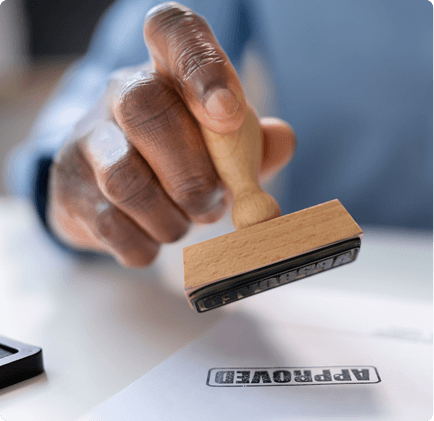Patent application drafting and prosecution require a combination of technical expertise, legal knowledge, and communication skills. It is a process that can span several years, and the outcome has significant implications for protecting intellectual property and potentially generating revenue through licensing or litigation. The process can be expedited by filing an application under the Track One Prioritized Examination program.
Overview of a patent application life cycle:
1. Invention Disclosure:
The process typically begins when an inventor or a company identifies a novel and non-obvious invention and provides a write up including a summary and possible drawings or sketches to a patent practitioner.
2. Prior Art Search:
Before drafting a patent application, a search for prior art (e.g., existing patents and publications) may be conducted to determine the novelty and non-obviousness of the invention.
While a search prior to filing a patent application is not strictly required, the search helps in assessing whether the invention meets patentability criteria.
3. Patentability Assessment:
Based on the prior art search results, an attorney or patent agent assesses whether the invention is eligible for patent protection.
This assessment considers criteria such as novelty, non-obviousness, usefulness, and patentable subject matter.
4. Drafting the Patent Application:
A patent practitioner drafts a patent application, which includes:
A detailed description of the invention (i.e., a specification) that provides a clear and complete disclosure of how to make and use the invention.
Claims: The most crucial part of the application are the claims. The claims define the scope (i.e., the metes and bounds) of protection sought. These are carefully crafted to balance breadth and specificity.
Drawings and diagrams to illustrate the invention.
An abstract and background section to provide context.

5. Filing the Patent Application:
The patent application is filed with the relevant patent office, such as the United States Patent and Trademark Office (USPTO) or the European Patent Office (EPO).
The filing date is critical as it establishes the priority date (i.e., the “patent pending” date), which determines who has the right to patent a similar invention later.
6. Patent Examination:
The patent office assigns an examiner to review the application. The examiner assesses whether the application complies with patent laws and examines the prior art.
The patent practitioner and examiner may engage in a series of communications (a process referred to as “patent prosecution”) to clarify and negotiate the scope of the claims.
7. Office Actions and Amendments:
The patent office may issue office actions, raising concerns or rejections. We expect to receive at least one office action for most patent applications.
The applicant responds with amendments to the application, arguments, or evidence to overcome the rejections.
This process can involve multiple rounds of office actions and responses.
8. Grant or Abandonment:
If the patent office is satisfied with the initial patent application or with the responses and amendments filed in response to one or more office actions, then the patent office will issue a Notice of Allowance.
The applicant pays issues fees (and later maintenance fees starting 3.5 years after patent issuance) and complies with any final requirements to secure the patent.
9. Post-Grant Maintenance:
Once granted, the patent holder is responsible for maintaining the patent by paying maintenance fees (beginning at 3.5 years after patent issuance) and ensuring that it’s enforced.
10. Enforcement and Licensing:
The patent owner has the exclusive right to enforce their patent and can license or sell those rights to others.
Trademark application preparation and filing is a crucial step in protecting intellectual property rights, establishing brand identity, and developing a robust IP portfolio. Trademarks can include brand names, logos, slogans, and other distinctive marks that identify and distinguish products or services in the marketplace.
1. Initial Trademark Search:
Before filing a trademark application, it is important to conduct at least a cursory trademark search to check for conflicts with existing trademarks. This search helps identify potentially conflicting marks and assesses the likelihood of successful registration.
2. Identifying Trademark Eligibility:
Not all words, symbols, or designs can be registered as trademarks. To be eligible, a trademark must be distinctive and not generic. Descriptive marks may be eligible if they acquire secondary meaning through extensive use.
3. Determining the Appropriate Trademark Class:
Trademarks are categorized into classes based on the types of goods or services they represent. It’s crucial to accurately determine the relevant class(s) for your trademark(s). Multiple classes may be necessary if your brand covers various goods or services.
4. Trademark Application Drafting:
The trademark application is prepared, including the following components:
The trademark itself, presented in the preferred format (e.g., word mark, logo, combination mark, etc.).
A clear description of the goods or services associated with the trademark.
The applicant’s name and contact information. The basis for filing (e.g., actual use in commerce or intent to use).

A specimen of the trademark (if the mark is in actual use). As an example, an image of a website offering a product for sale can be submitted as a specimen to show actual use of the mark.
5. Filing the Trademark Application:
The trademark application is filed with the appropriate trademark office, such as the United States Patent and Trademark Office (USPTO) in the United States. A filing fee is paid at the time of submission.
6. Examination and Office Actions:
After filing, the trademark office assigns an examiner to review the application. The examiner checks for compliance with trademark laws, including distinctiveness and potential conflicts with existing marks. If there are issues, the examiner issues an office action, specifying the problems that need to be addressed. The applicant responds to the office action, either amending the application or providing arguments to overcome objections.
7. Publication and Opposition:
If the trademark office approves the application, it is published in the official gazette or a similar publication for public review. During this period, third parties have an opportunity to oppose the registration if they believe it conflicts with their own trademarks.
8. Registration and Maintenance:
If there are no oppositions or if opposition proceedings are resolved in favor of the applicant, the trademark is registered. Trademark owners must maintain their trademarks by renewing them periodically and ensuring they are used consistently.
9. Enforcement:
Registered trademark owners have the exclusive right to use their mark on the specified goods or services. They can enforce these rights through legal actions against infringing parties.
Patent searches, also known as patentability searches or prior art searches, are investigations conducted to assess the novelty and inventiveness of an invention before pursuing a patent application. There is no strict requirement that a patent search be conducted before a patent application is filed.
1. Purpose of Patent Searches:
Patent searches aim to determine whether an invention is novel and non-obvious, which are key requirements for obtaining a patent.
They help identify existing patents, published patent applications, scientific literature, and other public disclosures (collectively referred to as “prior art”) relevant to the invention.
2. Types of Patent Searches:
Novelty Search (e.g., a patentability study): This search seeks to identify prior art that might invalidate a patent application due to lack of novelty. It focuses on finding earlier inventions or disclosures that are similar to the invention in question. A patentability study seeks to determine the likelihood that a particular invention could garner patent protection.
Freedom-to-Operate (FTO) Search: This search assesses whether a product or process might infringe existing patents. It particularly identifies patents and patent applications that could pose infringement risks.
State-of-the-Art Search: This broader search provides a comprehensive overview of the technological landscape related to a particular field. It helps inventors and businesses stay informed about existing technology trends.
3. Conducting the Patent Search:
Patent searches are often performed using specialized databases provided by patent offices, commercial patent search firms, and research institutions.
Searchers use a combination of keywords, classification codes, and Boolean operators to construct precise search queries.
Searches may cover multiple patent databases, including national and international patent offices (e.g., USPTO, EPO, WIPO), as well as non-patent literature sources like scientific journals and conference proceedings.
4. Analyzing Search Results:
Search results yield a list of relevant documents, including patents, patent applications, and publications.
Patent professionals analyze these documents to determine their relevance and impact on the patentability or FTO of the invention.
Each document is assessed to understand its technical content and how closely it relates to the invention.

5. Evaluating Patentability:
For a patentability search, the key question is whether the invention is novel and non-obvious in light of the discovered prior art.
Patents or disclosures that describe inventions similar to the one being considered may jeopardize its patentability.
6. Preparing for Patent Application:
The results of the search inform strategic decisions about whether to proceed with a patent application.
If highly relevant prior art is found, inventors and patent practitioners can adjust the patent application strategy, potentially narrowing the claims or focusing on unique aspects of the invention.
7. Freedom-to-Operate Assessment:
In an FTO search, the goal is to identify patents that could potentially be infringed by bringing the invention to market.
If problematic patents are found, legal counsel can help devise strategies to navigate potential infringement risks, such as licensing negotiations or design modifications.
8. Continuous Monitoring:
Patent searches are not limited to the pre-application stage. Ongoing monitoring of patent databases and relevant literature helps businesses stay updated on new developments in their field and potential infringement risks.
Sophisticated patent searches require a combination of technical expertise, legal knowledge, and search strategy. They are a critical step in the intellectual property process, providing the foundation for informed decisions about pursuing patents, mitigating risks, and ensuring compliance with patent laws and regulations. Legal professionals, patent agents, and experienced search specialists often play key roles in conducting and interpreting these searches.
Intellectual property (IP) portfolio development and management is a strategic process that involves the acquisition, protection, and optimization of a company’s intellectual assets, including patents, trademarks, copyrights, trade secrets, and other intangible assets.
1. Intellectual Property Strategy:
Portfolio development begins with a well-defined IP strategy aligned with the company’s business objectives. This strategy outlines goals, budget, and the types of IP assets to be pursued.
2. Identifying Intellectual Property Assets:
Companies identify and categorize their intellectual assets, including inventions, trademarks, copyrights, and trade secrets.
These assets are evaluated for their strategic importance, market value, and potential for revenue generation.
3. Prioritization and Evaluation:
Assets are prioritized based on their strategic value and potential return on investment (ROI).
A comprehensive evaluation assesses the technical strength, market potential, competitive landscape, and legal risks associated with each IP asset.
4. Patent Portfolio Development:
For inventions and innovations, patent applications are prepared and filed in relevant jurisdictions.
Patent prosecution involves interactions with patent offices to secure patent grants.
Strategies such as provisional patent applications, continuation applications, and divisional applications may be employed to maximize protection.

5. Trademark Portfolio Development:
Trademarks are registered for brand names, logos, slogans, and other identifiers.
International trademark registrations may be pursued to protect the brand globally.
6. Copyright and Trade Secret Protection:
Copyrights are registered for creative works, and trade secrets are safeguarded through internal policies and agreements.
Non-disclosure agreements (NDAs) and confidentiality measures are essential for trade secret management.
7. IP Enforcement and Defense:
Companies actively monitor their IP portfolio to detect infringement.
Legal actions may be taken against infringers to protect IP rights, and defenses may be mounted against unfounded claims.
8. Licensing and Commercialization:
IP assets can be monetized through licensing agreements, partnerships, or selling IP rights.
Companies explore opportunities to commercialize their IP through collaborations, joint ventures, or spin-offs.
9. IP Portfolio Optimization:
Periodic reviews of the IP portfolio are conducted to identify underutilized or outdated assets.
Assets that no longer align with business goals may be divested or abandoned.
10. Risk Mitigation:
IP portfolio management also involves managing legal and financial risks associated with IP, including the risk of infringement claims or challenges to the validity of IP rights.
11. IP Portfolio Valuation:
Companies assess the value of their IP portfolio for financial reporting, mergers and acquisitions, or raising capital.
Various valuation methods, including cost-based, market-based, and income-based approaches, may be employed.
12. Compliance and Record Keeping:
Effective IP portfolio management includes maintaining accurate records of IP assets, agreements, and enforcement actions.
Compliance with legal and regulatory requirements is crucial to avoid the loss of IP rights.
Sophisticated intellectual property portfolio development and management require a multidisciplinary approach, involving legal, technical, financial, and strategic expertise. It’s an ongoing process that adapts to changes in technology, market conditions, and business objectives. IP professionals, including patent attorneys, trademark attorneys, IP consultants, and licensing experts, often play critical roles in this complex and strategically significant area of business management.
Intellectual property (IP) opinions are legal assessments and recommendations provided by specialized IP attorneys or experts to sophisticated clients, including businesses, inventors, and legal professionals. These opinions serve to inform and guide decision-making related to intellectual property rights, potential legal risks, and strategies.
1. Patentability Opinion:
Purpose: To assess whether an invention is likely to meet the patentability criteria (novelty, non-obviousness, and utility) and whether pursuing a patent is advisable.
Process: A patent practitioner conducts a prior art search and reviews the invention’s technical details.
Outcome: The opinion may recommend filing a patent application or offer insights on how to strengthen the application.
2. Freedom-to-Operate (FTO) Opinion:
Purpose: To evaluate whether a proposed product, technology, or process infringes existing patents.
Process: A thorough search is conducted to identify relevant patents, followed by a legal analysis to determine infringement risks.
Outcome: The opinion helps clients make informed decisions about launching a product or taking steps to avoid potential infringement.
3. Validity Opinion:
Purpose: To assess the validity of a granted patent, especially when considering a challenge or litigation.
Process: The patent is scrutinized for possible flaws in its issuance, including prior art not considered during examination.
Outcome: The opinion can inform whether to proceed with litigation, negotiations, or a post-grant procedure such as an Inter Partes Review.
4. Non-Infringement Opinion:
Purpose: To determine whether a product, process, or activity might infringe a specific patent.
Process: A legal analysis is conducted to assess whether the patent’s claims cover the client’s activities.
Outcome: The opinion helps clients mitigate infringement risks and potentially modify their products or processes.

5. Clearance or Right-to-Use Opinion:
Purpose: Similar to FTO opinions, these assess whether using a particular intellectual property (e.g., a trademark) would infringe existing rights.
Process: Searches and legal analysis are conducted to determine the risk of infringement.
Outcome: Clients receive guidance on whether they can use a particular IP asset without violating others’ rights.
6. IP Portfolio Assessment:
Purpose: To evaluate the overall strength, value, and strategic alignment of an organization’s IP portfolio.
Process: Comprehensive analysis considers the quality, quantity, and relevance of IP assets.
Outcome: The assessment helps clients make informed decisions about portfolio optimization, divestment, or licensing opportunities.
7. Opinion for IP Transactions:
Purpose: To assess the IP involved in mergers, acquisitions, licensing deals, or joint ventures.
Process: Detailed examination of IP assets, agreements, and potential legal risks.
Outcome: Clients are informed about the IP’s value, potential liabilities, and negotiation strategies.
8. Due Diligence Opinion:
Purpose: To assess the IP aspects of a target company during due diligence for investment or acquisition.
Process: Comprehensive review of IP assets, IP-related agreements, and legal risks.
Outcome: Helps potential investors or acquirers make informed decisions about the target company’s IP.
We are able to provide intellectual property litigation support, including the following:
1. Prior Art Search and Analysis:
Conducting comprehensive searches to identify relevant prior art (existing patents, publications, and other references) that may affect the validity or infringement of a patent.
2. Patent Analysis and Evaluation:
Assessing the strength and validity of patents, including claim construction, patent prosecution history, and potential vulnerabilities.
3. Claim Charting and Infringement Analysis:
Preparing claim charts that compare the claims of the asserted patent(s) to the accused product or technology to assess infringement.
4. Invalidity Analysis:
Conducting in-depth research and analysis to identify prior art that can invalidate the asserted patent(s) and weaken the plaintiff’s case.

5. Patent Portfolio Assessment:
Evaluating the overall strength and strategic value of a client’s patent portfolio, including identifying assets that may be used defensively or offensively in litigation.
6. Litigation Strategy and Consulting:
Providing strategic guidance and advice on the best approach to a patent litigation case, including settlement negotiations, trial preparation, and risk assessment.
7. Markman Hearing Support:
Assisting attorneys in preparing for Markman hearings, which focus on claim construction, a critical aspect of patent litigation.
8. Post-Trial and Appellate Support:
Handling post-trial matters, including appeals, enforcement of judgments, and further litigation strategy if necessary.
9. Alternative Dispute Resolution (ADR) Support:
Assisting with negotiations, mediation, and arbitration to resolve patent disputes outside of court.
10. International Patent Litigation Support:
Providing expertise in cross-border patent litigation matters, including understanding and navigating the complexities of international patent laws and treaties.